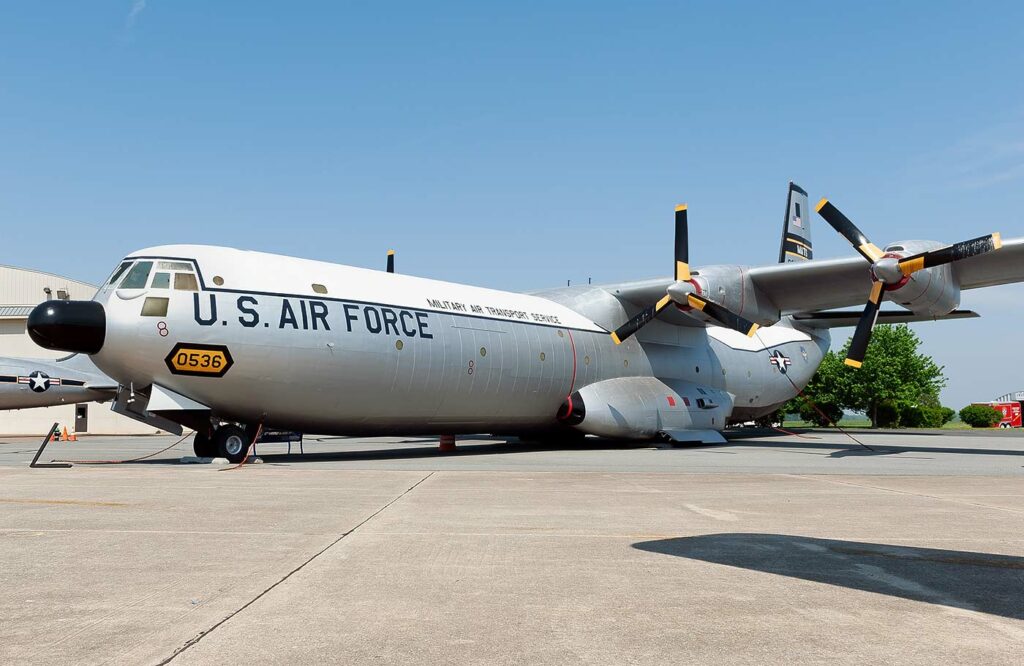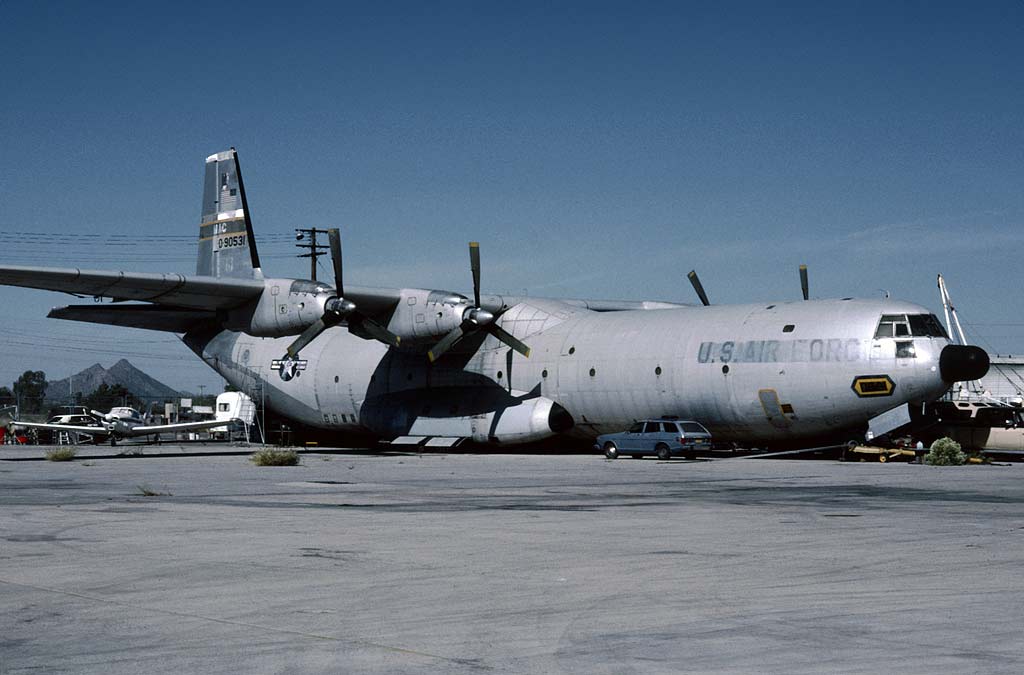The Douglas C-133 Cargomaster is a strategic airlift cargo aircraft, turboprop-powered, designed for the USAF to transport large and heavy cargo.
Technical Summary
The Douglas C-133 Cargomaster was a high-wing, strategic airlift cargo aircraft developed by Douglas Aircraft Company in the 1950s for the United States Air Force (USAF). It was one of the first aircraft designed specifically to transport large and outsized cargo, including military vehicles, ballistic missiles, and other heavy machinery. Powered by four Pratt & Whitney T34 turboprop engines, the C-133 had a maximum payload capacity of approximately 110,000 pounds (50,000 kg) and could cover a range of up to 3,800 miles (6,115 kilometers) at a cruising speed of 312 mph (502 km/h). With its large cargo doors and spacious cargo hold, the Cargomaster set new standards for air transport capabilities during its time, despite facing operational challenges and being eventually surpassed by newer cargo aircraft models.
The Douglas C-133 Cargomaster represented a significant advancement in military logistics and cargo transport capabilities during the Cold War era. As the USAF’s requirements for strategic airlift capacity expanded with the advent of intercontinental ballistic missiles and other oversized military equipment, the need for a dedicated heavy-lift transport aircraft became apparent. The C-133 Cargomaster was developed to meet this need, offering unparalleled cargo handling capabilities at the time of its introduction.

History of the Development of the Douglas C-133 Cargomaster
In the early 1950s, the United States Air Force identified a critical gap in its strategic airlift capabilities. Existing transport aircraft were incapable of handling the size and weight of the emerging generation of military equipment, particularly intercontinental ballistic missiles (ICBMs) like the Atlas and Titan. In response, the USAF issued a requirement for a new cargo aircraft that could fulfill this strategic logistics role.
Douglas Aircraft Company, building on its experience with the C-124 Globemaster II, proposed the C-133 Cargomaster as a solution. The development program was launched in 1952, with a focus on creating an aircraft that could transport large and heavy payloads over long distances without the need for disassembly.
The C-133 made its first flight on April 23, 1956, marking the beginning of a new era in strategic airlift. The aircraft did not receive a specific NATO nickname, reflecting its unique role within the United States Air Force rather than broader NATO operations.
Design of the Douglas C-133 Cargomaster
The design of the C-133 Cargomaster was revolutionary for its time. It featured a high-wing configuration to facilitate easy loading and unloading of cargo through large doors located at the rear of the aircraft. The C-133 was equipped with four Pratt & Whitney T34 turboprop engines, each delivering 7,500 horsepower, which provided the necessary thrust to lift heavy payloads.
The aircraft had a length of 157 feet 6 inches (48 meters), a wingspan of 179 feet 8 inches (54.8 meters), and a height of 48 feet 3 inches (14.7 meters), making it one of the largest cargo aircraft of its era. The cargo hold was designed to be spacious and versatile, capable of accommodating a wide range of military cargo, from trucks and tanks to missile components and satellites.
One of the most innovative features of the C-133 was its automated cargo handling system, which significantly reduced loading and unloading times. However, the aircraft also faced challenges, including reliability issues with its engines and airframe, which limited its operational lifespan.
Performance of the Douglas C-133 Cargomaster
The C-133 Cargomaster’s performance was impressive for a cargo aircraft of its size and era. It could achieve a maximum speed of 312 mph (502 km/h), with a range of up to 3,800 miles (6,115 kilometers) when fully loaded. Its service ceiling reached 32,000 feet (9,754 meters), enabling it to avoid most adverse weather conditions during flight.
Comparatively, the C-133 offered superior cargo capacity and range to its predecessor, the C-124 Globemaster II, and was unmatched by any other cargo aircraft in the USAF inventory at the time. However, it was eventually surpassed by the Lockheed C-5 Galaxy, which offered greater payload capacity, range, and reliability.
Variants of the Douglas C-133 Cargomaster
The C-133 Cargomaster was produced in two main variants: the C-133A and the C-133B. The C-133A was the initial production model, with a total of 35 aircraft built. The C-133B followed with an extended fuselage for increased cargo capacity, improved avionics, and enhanced performance, with 15 units produced. Both variants played crucial roles in strategic airlift missions throughout their service life.

Military Use and Combat of the Douglas C-133 Cargomaster
The C-133 Cargomaster was primarily used for strategic airlift missions by the United States Air Force. It played a pivotal role in transporting critical military cargo, including ICBMs, space vehicles for NASA, and supplies for the Vietnam War. The C-133’s ability to carry oversized cargo directly to forward operating bases significantly enhanced the USAF’s rapid deployment capabilities.
Despite its strategic importance, the C-133 did not see direct combat use, as its role was focused on logistics and support. However, its contributions to military operations, particularly during the Cold War and Vietnam War, were invaluable. The aircraft’s operational challenges and the advent of more advanced cargo planes led to its retirement in 1971, with the C-5 Galaxy taking over its strategic airlift role.
The Douglas C-133 Cargomaster was a pioneering aircraft that significantly advanced the United States Air Force’s strategic airlift capabilities. Its development and service marked a crucial period in military logistics, enabling the rapid transport of large and heavy cargo across global distances. Despite facing operational challenges, the C-133’s contributions to military and space operations during its service life underscore its importance in the history of military aviation. As technology advanced, the Cargomaster’s legacy continued through the development of newer, more capable cargo aircraft, cementing its place in the annals of aviation history.
Back to Transport planes.